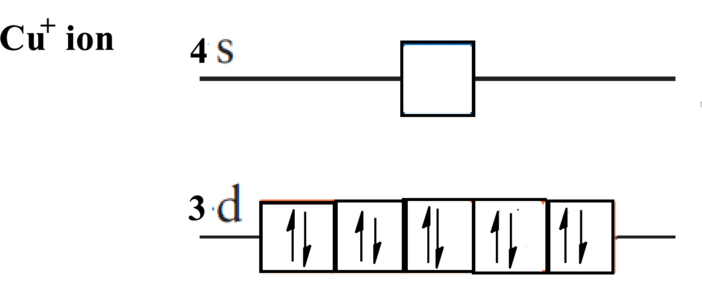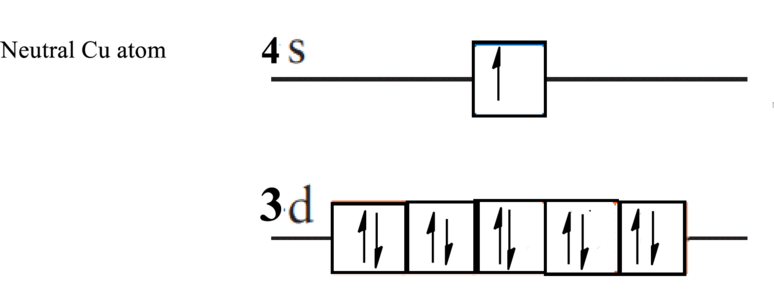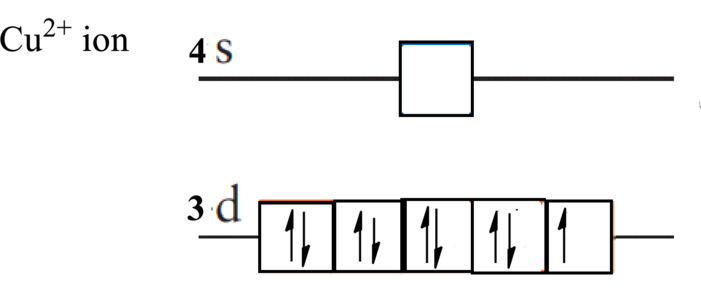
(a)
Interpretation:
The electronic configuration of
Concept Introduction:
The fundamental principles that are followed to write an electronic configuration include three rules as follows:
Electron in a

Hund’s rule suggests electrons are not allowed to be paired up until each degenerate set of orbital has got at least one electron.
Pauli Exclusion Principle states two electrons within the same orbital cannot possess same set for four possible quantum numbers.
(a)
Answer to Problem 2A.1AST
The electronic configuration of
Explanation of Solution
Copper is a d-block metal that loses it valence electrons to form

After a loss of one electron from the valence

(b)
Interpretation:
The electronic configuration of
Concept Introduction:
Refer to part (a).
(b)
Answer to Problem 2A.1AST
The electronic configuration of
Explanation of Solution
Copper is a d-block metal that loses its valence electrons to form

After loss of two electron from the valence

Want to see more full solutions like this?
Chapter 2 Solutions
CHEMICAL PRINCIPLES (LL) W/ACCESS
- What are the chemical formulas for ( a ) disulfur dioxide and ( b ) iodine pentafluoride ?arrow_forwardUsing Lewis electron-dot symbols to depict the monatomic ions formed from each of the following reactants, predict the formula of the compound the ions produce.(Type your answer using the format CO2 for CO2.) (a) O and Ca (b) N and Mg (c) Br and Li (d) K and Parrow_forwardDiscuss each conclusion from a study of redox reactions:(a) The nitride ion functions only as a reducing agent.(b) The nitrate ion functions only as an oxidizing agent.(c) The nitrite ion functions as an oxidizing or a reducing agentarrow_forward
- Write the ground state electron configuration for atom and ion pair. Co, Co2+arrow_forwardFor many years after they were discovered, it was believed that the noble gases could not form compounds. Now we know that belief to be incorrect. A mixture of xenon and fluorine gases, confined in a quartz bulb and placed on a windowsill, is found to slowly produce a white solid. Analysis of the compound indicates that it contains 77.55% Xe and 22.45% F by mass.(a) What is the formula of the compound?(b) Write a Lewis structure for the compound.(c) Predict the shape of the molecules of the compound.(d) What hybridization is consistent with the shape you predicted?arrow_forwardPredict the ion generally formed by (a) Sr, (b) S, (c) Al.arrow_forward
- Choosing from the elements in the third row of the Periodic Table write out thechemical formula of(i) A basic oxide.(ii) An amphoteric oxide.(iii) An acidic oxidearrow_forwardWrite the electron configuration for each of the followingions, and determine which ones possess noble-gasconfigurations: (a) Sr2+, (b) Ti2+, (c) Se2-, (d) Ni2+, (e) Br-,(f) Mn3 + .arrow_forwardWrite the electron configurations for the following ions, anddetermine which have noble-gas configurations: (a) Co2+ ,(b) Sn2+ , (c) Zr4+ , (d) Ag+, (e) S2- .arrow_forward
- 3. Write a chemical equation corresponding to the second ionization energy of calcium.arrow_forwardwrite the full electron configuration for the calcium (Ca2+)ionarrow_forwardDiscuss each conclusion from a study of redox reactions:(a) The sulfide ion functions only as a reducing agent.(b) The sulfate ion functions only as an oxidizing agent.(c) Sulfur dioxide functions as an oxidizing or a reducing agentarrow_forward
 Chemistry: The Molecular ScienceChemistryISBN:9781285199047Author:John W. Moore, Conrad L. StanitskiPublisher:Cengage Learning
Chemistry: The Molecular ScienceChemistryISBN:9781285199047Author:John W. Moore, Conrad L. StanitskiPublisher:Cengage Learning Chemistry for Engineering StudentsChemistryISBN:9781337398909Author:Lawrence S. Brown, Tom HolmePublisher:Cengage LearningChemistry: Matter and ChangeChemistryISBN:9780078746376Author:Dinah Zike, Laurel Dingrando, Nicholas Hainen, Cheryl WistromPublisher:Glencoe/McGraw-Hill School Pub Co
Chemistry for Engineering StudentsChemistryISBN:9781337398909Author:Lawrence S. Brown, Tom HolmePublisher:Cengage LearningChemistry: Matter and ChangeChemistryISBN:9780078746376Author:Dinah Zike, Laurel Dingrando, Nicholas Hainen, Cheryl WistromPublisher:Glencoe/McGraw-Hill School Pub Co Chemistry: Principles and PracticeChemistryISBN:9780534420123Author:Daniel L. Reger, Scott R. Goode, David W. Ball, Edward MercerPublisher:Cengage Learning
Chemistry: Principles and PracticeChemistryISBN:9780534420123Author:Daniel L. Reger, Scott R. Goode, David W. Ball, Edward MercerPublisher:Cengage Learning Physical ChemistryChemistryISBN:9781133958437Author:Ball, David W. (david Warren), BAER, TomasPublisher:Wadsworth Cengage Learning,
Physical ChemistryChemistryISBN:9781133958437Author:Ball, David W. (david Warren), BAER, TomasPublisher:Wadsworth Cengage Learning, General, Organic, and Biological ChemistryChemistryISBN:9781285853918Author:H. Stephen StokerPublisher:Cengage Learning
General, Organic, and Biological ChemistryChemistryISBN:9781285853918Author:H. Stephen StokerPublisher:Cengage Learning





